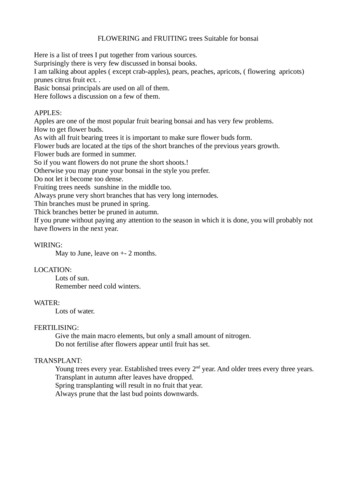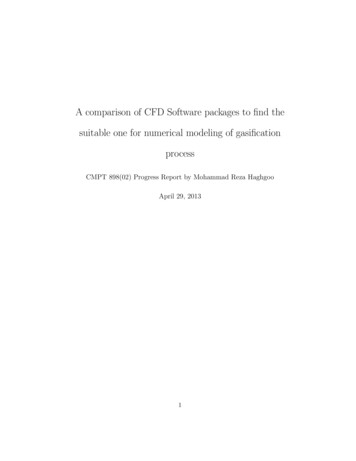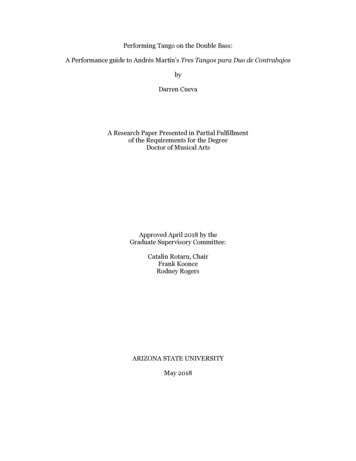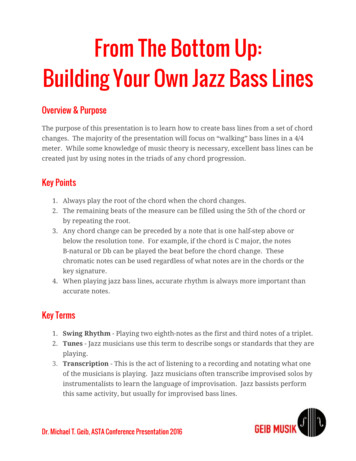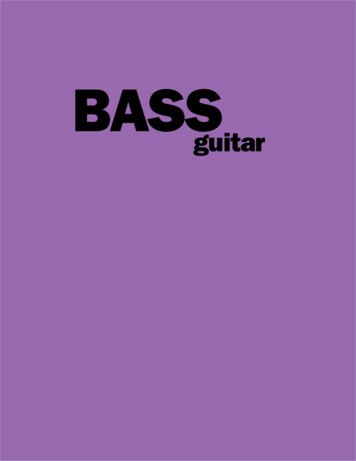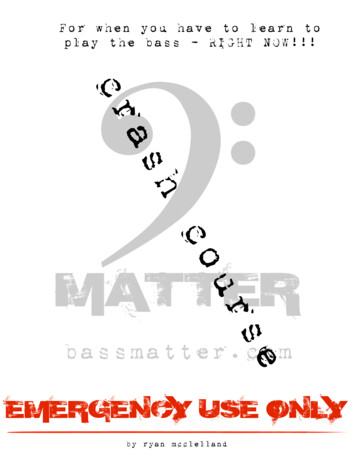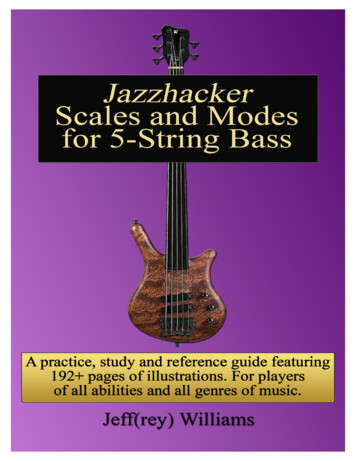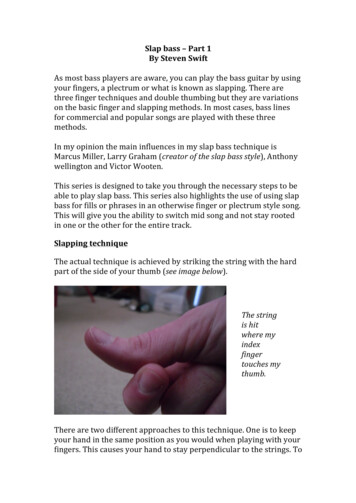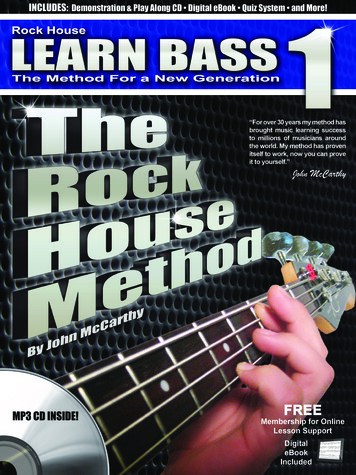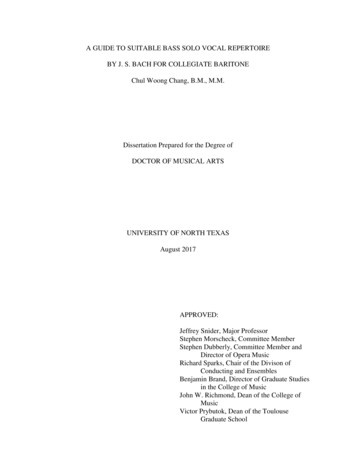
Transcription
A GUIDE TO SUITABLE BASS SOLO VOCAL REPERTOIREBY J. S. BACH FOR COLLEGIATE BARITONEChul Woong Chang, B.M., M.M.Dissertation Prepared for the Degree ofDOCTOR OF MUSICAL ARTSUNIVERSITY OF NORTH TEXASAugust 2017APPROVED:Jeffrey Snider, Major ProfessorStephen Morscheck, Committee MemberStephen Dubberly, Committee Member andDirector of Opera MusicRichard Sparks, Chair of the Divison ofConducting and EnsemblesBenjamin Brand, Director of Graduate Studiesin the College of MusicJohn W. Richmond, Dean of the College ofMusicVictor Prybutok, Dean of the ToulouseGraduate School
Chang, Chul Woong. A Guide to Suitable Bass Solo Vocal Repertoire by J. S. Bach forCollegiate Baritone. Doctor of Musical Arts (Performance), August 2017, 57 pp., 4 figures, 34musical examples, bibliography, 46 titles.In the Baroque period, the baritone voice was not yet well-defined, but many composerswrote vocal pieces with a range appropriate for the modern baritone voice. Composers used thegeneral categories of soprano, alto, tenor, and bass for solo voice in their compositions. JohannSebastian Bach (1685-1750) was no different from other Baroque composers in writing soloworks to be performed by one of the four main voice types. The various ranges and tessituras ofJ. S. Bach's vocal works for bass solo voice are not limited to being sung by low basses, but mayalso be sung by more medium ranged baritones. The purpose of this research is to guidecollegiate voice teachers and their baritone students in selecting appropriate repertoire from theworks of Bach on the basis of each students' level of development and to categorize four groupsof bass solos by Bach for collegiate baritone students: beginning level for freshmen, intermediatelevel for sophomores, advanced level for juniors and seniors, and pre-professional level forseniors and graduate students. This research was prepared in conjunction with a DMA lecturerecital of eight bass solos for collegiate baritone voice, selected from the study; two vocal worksfor each proficiency level.
Copyright 2017byChul Woong Changii
TABLE OF CONTENTSPageLIST OF FIGURES . ivLIST OF MUSICAL EXAMPLES .vCHAPTER 1. INTRODUCTION .1CHAPTER 2. THE BARITONE VOICE IN THE BAROQUE AND MODERN ERAS.3CHAPTER 3. BASS SOLO REPERTOIRE OF J. S. BACH FOR BARITONE VOICE .8CHAPTER 4. FOUR GROUPS OF BASS SOLOS CATEGORIZED FOR COLLEGIATEBARITONE .184.1.Beginning Level .204.2.Intermediate Level .254.3.Advanced Level .314.4.Pre-Professional Level .36CHAPTER 5. CONCLUSION.40APPENDIX A. CATALOG OF SUITABLE BASS ARIAS BY J. S. BACH FOR COLLEGATEBARITONE .42APPENDIX B. DETAILED TESSITURAS OF THE EIGHT SELECTED BASS SOLOS .49BIBLIOGRAPHY .54iii
LIST OF FIGURESPage1.The main French, German, and Italian categories of baritone voice by James Anderson . 42.The ranges of baritone by Manuel Garcia, James McKinney, and Owen Jander . 63.List of five secular arias for bass solo, containing high ranges and tessituras. 104.Extended range for each level of arias if lowest or highest notes are unstressed and short. 14iv
LIST OF MUSICAL EXAMPLESPage1.mm. 39-42 of “Eri tu che macchiavi quell'anima” from Un ballo in maschera .102.mm. 62-75 of “It is enough” from Elijah, op. 70.113.mm. 13-17 of “Et in Spiritum Sanctum” from the Mass in B minor, BWV 232.124.mm. 90-94 of “Et in Spiritum Sanctum” from the Mass in B minor, BWV 232 .125.mm. 87-89 of “Darum sollt ihr nicht sorgen” from BWV 187 .136.mm. 108-111 of “Greifet zu, fasst das Heil” from BWV 174 .137.mm. 48-49 of “Wie will ich lustig lachen” from BWV 205 .148.mm. 5-12 of “Was des Höchsten Glanz erfüllt” from BWV 194 .169.mm. 1-16 of “Es nehme zehntausend Dukaten” from BWV 212 .2110.mm. 1-6 of “Das is zu klug vor dich” from BWV 212 .2211.mm. 5-6 of “Das is zu klug vor dich” from BWV 212 .2212.mm. 1-4 of “Wisset ihr nicht” from BWV 154 .2313.mm. 4-10 of “Wisset ihr nicht” from BWV 154 .2414.mm. 8-9 of “Wisset ihr nicht” from BWV 154 .2415.mm. 19-20 of “Wisset ihr nicht” from BWV 154 .2516.mm. 19-20 of “Wisset ihr nicht” from BWV 154 .2517.mm. 1-6 of “Barrabas aber war ein Mörder” from the St. John Passion, BWV 245.2718.mm. 3-11 of “Betrachte, meine Seel, mit ängstlichem Vergnügen” from the St. JohnPassion, BWV 245.2819.mm. 14-15 of “Betrachte, meine Seel, mit ängstlichem Vergnügen” from the St. JohnPassion, BWV 245.2920.mm. 6-8 of “Ach, unser Wille bleibt verkehrt” from BWV 73 .3021.The main theme of “Herr, so du willt” in mm. 1-2 from BWV 73 .3022.measure 26 of “Herr, so du willt” from BWV 73 .31v
23.mm. 13-17 of “Herr, so du willt” from BWV 73 .3124.mm. 1-4 of “Es nehme zehntausend Dukaten” from BWV 212 and mm. 12-16 of “Nichtsist es spat und frühe” from BWV 97.3325.mm. 12-16 of “Nichts ist es spat und frühe” from BWV 97.3326.mm. 31-35 of “Nichts ist es spat und frühe” from BWV 97.3427.mm. 7-9 of “Am Abend, da es kühle war” from the St. Matthew Passion, BWV 244 .3428.mm. 10-11 of “Mache dich, mein Herze, rein” from the St. Matthew Passion, BWV244.3529.mm. 13-15 of “Mache dich, mein Herze, rein” from the St. Matthew Passion, BWV244.3630.measure 15 of “Mache dich, mein Herze, rein” from the St. Matthew Passion, BWV244.3631.mm. 58-64 of “Zurücke, zurücke, geflügelten Winde” from BWV 205 .3732.mm. 82-88 of “Zurücke, zurücke, geflügelten Winde” from BWV 205 .3833.mm. 150-156 of “Zurücke, zurücke, geflügelten Winde” from BWV 205 .3834.mm. 128-146 of “Gratias agimus tibi” from Mass in G major, BWV 236 .39vi
CHAPTER 1INTRODUCTIONIn the Baroque period, the baritone voice was not yet well-defined, but many composerswrote vocal pieces with a range appropriate for the modern baritone voice. Composers used thegeneral categories of soprano, alto, tenor, and bass for solo voice in their compositions.According to Richard Miller, the term “bass voice” in the Baroque period included the modernvoice type of the baritone; in addition, the medium vocal range of male voice in the seventeenthand eighteenth centuries was appropriate for the range of baritone we use today.1 JohannSebastian Bach (1685-1750), who composed numerous cantatas and other vocal music, was nodifferent from other Baroque composers in writing solo works to be performed by one of the fourmain voice types. The various ranges and tessituras of J. S. Bach’s vocal works for bass solovoice are not limited to being sung by low basses, but may also be sung by more medium rangedbaritones.The primary purpose of this research is to guide collegiate voice teachers and theirbaritone students in selecting appropriate repertoire from the works of J. S. Bach on the basis ofeach students’ level of development, including technique, voice range, and agility, and tocategorize four groups of bass solos by Bach for collegiate baritone students: beginning level forfreshmen, intermediate level for sophomores, advanced level for juniors and seniors, and preprofessional level for seniors and graduate students. As young baritone students gain betterbreath control, vocal agility, and a wider voice range through proper training with their voiceinstructor, they may advance to the next level of arias. With these vocal works of J. S. Bach,1Richard Miller, National Schools of Singing: English, French, German, and Italian Techniques of SingingRevisited (London: The Scarecrow Press, Inc., 1977), 164.1
baritone singers can prepare for competitions and auditions which require an oratorio or cantataaria composed before 1800, such as the NATS (National Association of Teachers of Singing)National Student Auditions and Artist Awards. Furthermore, this repertoire will help students toperform on the recital stage or in church services, since many voice students serve as a sectionleader in church choir.This study is limited to J. S. Bach’s bass solo arias and ariosos from sacred and secularcantatas, masses, passions, and oratorios between BWV 1 and BWV 249. The study will notcover doubtful and spurious works no longer considered Bach’s compositions, such as BWV 15,probably written by Johann Ludwig Bach; BWV 141, attributed to Georg Philipp Telemann; andBWV 142, attributed to Johann Kuhnau.2This research was prepared in conjunction with a DMA lecture-recital of eight bass solosfor collegiate baritone voice, selected from the study; two vocal works for each proficiency level.The appendix contains the lists of suitable bass repertoire from J. S. Bach for collegiate baritonevoice which divide each group from beginning to pre-professional level according to range,tessitura, and length of melismas.2James C. McKinney, “The Solo Bass Voice in the Cantatas of J. S. Bach” (Doctoral diss., University of SouthernCalifornia, 1969), 289, 305.2
CHAPTER 2THE BARITONE VOICE IN THE BAROQUE AND MODERN ERASThe term baritone originates from late fifteenth-century French polyphonic sacred musicas a signification of a voice lower than bass. Franchinus Gaffurius used baritonus, which meansa deep voice, for the lowest part of the four normal voices in his Practica musicae composed in1496. In seventeenth-century Italy, the term baritone was used for choral singers who sang lowparts. In 1732, Johann Gottfried Walther wrote in Musicalisches Lexicon that baritone must haveaspects of both the high range of the tenor and the depth of the bass.3 According to Owen Janderin The New Grove Dictionary of Music and Musicians:Mozart’s leading roles for baritone and bass-baritone derive from the Basso buffotradition, in which no clear distinction is drawn between bass and baritone. The firstCount Almaviva (Le nozze di Figaro), Stefano Mandini, described as a ‘primo buffomezzo carattere’, had a voice that would now be considered a baritone.4Until the nineteenth century, the term baritone was not frequently used by composers of operasand vocal music. Nevertheless, many opera and oratorio arias from the seventeenth andeighteenth centuries are considered suitable repertoire for baritones.According to modern performance practice, many European opera theaters in thetwentieth and twenty-first centuries have used the Fach system, which categorizes a widervariety of voice types than were understood in the Baroque period. The German word Fachtranslates to “category,” or “specialty.” In the Fach system, there are more than twenty-five3Owen Jander, J. B. Steane, and Elizabeth Forbes, "Baritone." The New Grove Dictionary of Music and Musicians,2nd ed. ed. Stanly Sadie (New York: Grove‘s Dictionaries Inc., 2001), 731.4Ibid., 731.3
different vocal classifications. For example, the baritone voice is divided into severalclassifications, such as Heldenbariton (Literally “Heroic” Baritone), who has an authoritativesound and a heavier and darker timbre; Lyrischer Bariton (Lyric Baritone), having “a smooth,beautiful, [and] flexible voice with a bel canto line and effective top;” and Ka
general categories of soprano, alto, tenor, and bass for solo voice in their compositions. Johann Sebastian Bach (1685-1750) was no different from other Baroque composers in writing solo works to be performed by one of the four main voice types. The various ranges and tessituras of J. S. Bach's vocal works for bass solo voice are not limited to being sung by low basses, but may also be sung by .

